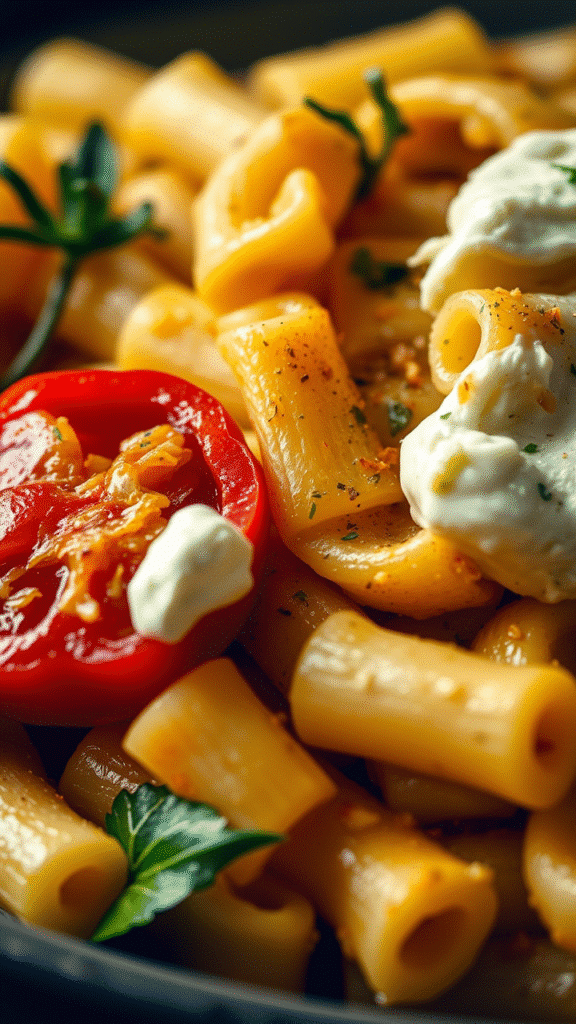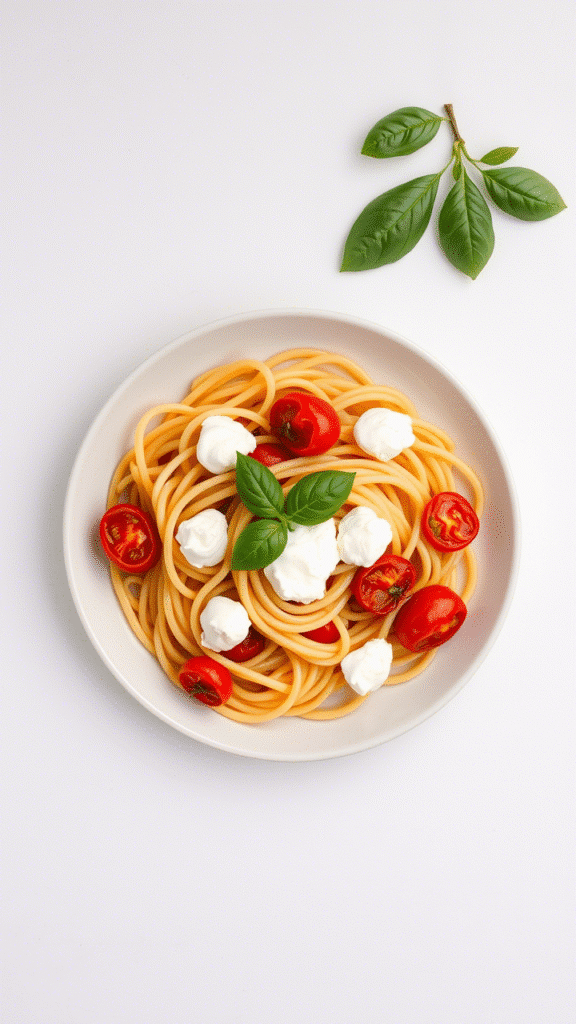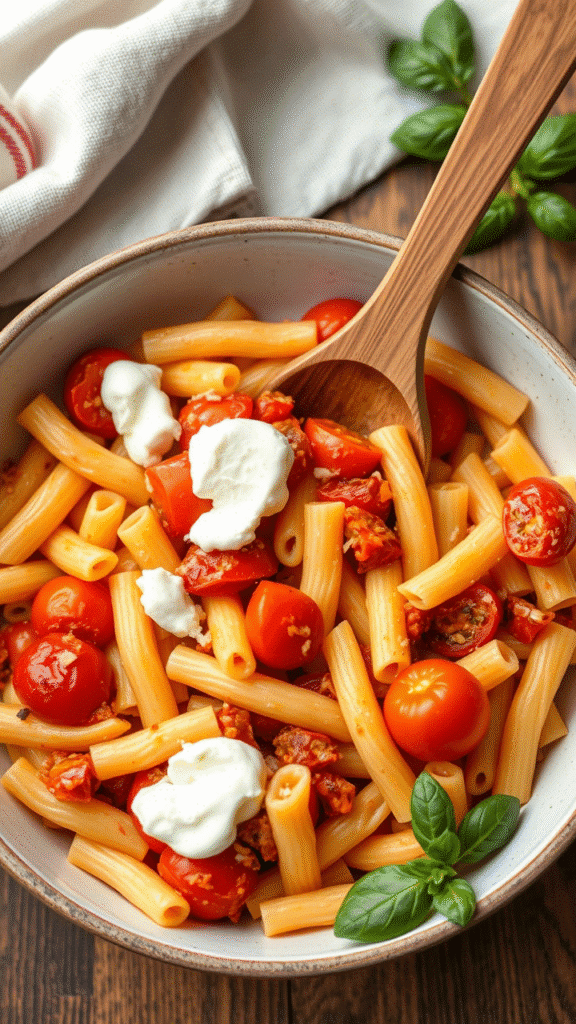Last Tuesday evening, while cleaning out my walk-in cooler, I discovered a case of San Marzano tomatoes that had been sitting there for three days—perfectly ripe, almost bursting with juice. Instead of letting them go to waste, I decided to create something that would showcase their natural sweetness through slow roasting. What emerged from my oven two hours later became one of the most requested dishes at my restaurant.
This isn’t your typical weeknight pasta. Roasted Tomato and Garlic Ricotta Pasta represents the intersection of rustic Italian tradition and modern technique—where time becomes an ingredient as crucial as the tomatoes themselves. The slow roasting process concentrates flavors while creating those coveted caramelized edges that add depth you simply can’t achieve through quick sautéing.
What makes this dish extraordinary is how the roasted tomatoes meld with fresh ricotta, creating a sauce that’s neither too heavy nor too light. The garlic, roasted until golden and sweet, provides an aromatic backbone that ties everything together. It’s comfort food elevated to restaurant quality.
Why This Recipe Stands Apart
Professional kitchens have taught me that the best dishes often rely on restraint rather than complexity. This pasta exemplifies that philosophy perfectly. By focusing on just a few high-quality ingredients and treating them with respect, you create something far greater than the sum of its parts.
The roasting technique transforms ordinary tomatoes into concentrated flavor bombs. When combined with creamy ricotta and properly cooked pasta, the result is a dish that feels both familiar and sophisticated. It’s the kind of recipe that separates good cooks from great ones—not because it’s difficult, but because it requires patience and understanding of how heat affects ingredients.
Ingredients & Substitutions
Primary Ingredients
- 2 pounds Roma or San Marzano tomatoes, halved lengthwise
- 1 head garlic, top sliced off to expose cloves
- 1 pound high-quality dried pasta (penne, rigatoni, or shells work best)
- 16 ounces whole milk ricotta cheese
- 1/2 cup extra virgin olive oil, divided
- 1/4 cup fresh basil leaves, torn
- 1/2 cup freshly grated Parmigiano-Reggiano
- 2 teaspoons sea salt
- 1 teaspoon freshly cracked black pepper
- 1/4 teaspoon red pepper flakes (optional)
Professional Substitution Guide
When San Marzanos aren’t available, Roma tomatoes work beautifully—just choose ones that feel heavy for their size with minimal give when pressed. Cherry tomatoes can substitute but will need less roasting time, about 25-30 minutes instead of 45.
For the ricotta, seek out whole milk versions from local dairies if possible. Part-skim ricotta lacks the creamy richness that makes this sauce sing. In a pinch, mascarpone mixed with a splash of milk creates similar results, though it’s significantly richer.
The pasta shape matters more than you might think. You want something with ridges or curves that can hold the chunky sauce. Penne rigate, shells, or even orecchiette work wonderfully. Avoid long, thin pastas like spaghetti—they won’t capture the roasted tomato pieces effectively.
Fresh basil is non-negotiable here. Dried basil won’t provide the bright, peppery notes that balance the sweet roasted tomatoes. If you absolutely must substitute, try fresh oregano or even arugula for a different but still delicious result.
Step-by-Step Instructions

Preparing the Roasted Elements
Preheat your oven to 400°F—this temperature gives you the perfect balance between caramelization and even cooking. Line a large rimmed baking sheet with parchment paper, which prevents sticking and makes cleanup easier.
Cut your tomatoes in half lengthwise, not crosswise. This exposes more surface area to the heat and prevents them from falling apart completely. Arrange them cut-side up on your prepared baking sheet, leaving space between each piece for proper air circulation.
Drizzle the tomatoes with 1/4 cup olive oil and season generously with salt and pepper. Don’t be shy with the seasoning—tomatoes can handle it, and proper seasoning at this stage builds the foundation of flavor.
Place the whole head of garlic, cut-side down, directly on the baking sheet next to the tomatoes. Drizzle it with a tablespoon of olive oil and wrap it loosely in foil. This prevents the garlic from burning while allowing it to roast slowly.
The Roasting Process
Slide everything into the oven and set a timer for 45 minutes. After about 25 minutes, check the garlic—it should be golden and soft when pressed. If it’s browning too quickly, cover it more completely with foil.
The tomatoes are done when their edges are caramelized and slightly shriveled, but they still hold their shape. Some liquid will have evaporated, concentrating the flavors beautifully. If they’re browning too quickly, lower the oven temperature to 375°F and continue cooking.
Once finished, let everything cool for about 10 minutes. The garlic cloves should squeeze out easily when pressed, and the tomatoes should have a jammy consistency around the edges while maintaining some texture in the center.
Building the Sauce
While your vegetables cool, bring a large pot of salted water to a rolling boil. Use about 2 tablespoons of salt per gallon of water—it should taste like the sea. This is your only chance to season the pasta itself.
Squeeze the roasted garlic cloves into a large mixing bowl and mash them with a fork until relatively smooth. Add the ricotta and mix well, creating a creamy base for your sauce. Season this mixture with salt and pepper to taste.
Add the cooked pasta to the bowl while it’s still hot and steaming. The residual heat will warm the ricotta mixture without making it grainy—a common mistake when ricotta gets too hot. Toss everything together with pasta water as needed.
Final Assembly
Gently fold in the roasted tomatoes, being careful not to break them up completely. You want some chunky pieces for texture and visual appeal. Add the torn basil leaves and half the Parmigiano-Reggiano.
Taste and adjust seasoning—you might need more salt, pepper, or even a splash of good olive oil to bring everything together. The sauce should coat the pasta lightly without being heavy or overwhelming.
Cooking Techniques & Science

Understanding the Maillard Reaction
The magic of this dish happens during the roasting process, where the Maillard reaction creates those deeply flavorful, caramelized edges on the tomatoes. This chemical reaction between amino acids and sugars occurs around 300°F, which is why we roast at 400°F—hot enough to trigger the reaction but not so hot that the tomatoes burn before they caramelize.
The slow roasting also concentrates the tomatoes’ natural glutamates, creating a deeper umami flavor that enhances the overall dish. This is why roasted tomatoes taste so much more intense than fresh ones—you’re literally concentrating their essence through controlled dehydration.
The Science of Ricotta Integration
Ricotta can be tricky to work with in hot preparations because it tends to break and become grainy when overheated. By mixing it with the roasted garlic first and then combining it with hot pasta (rather than cooking it directly), we warm the cheese gently, maintaining its creamy texture.
The pasta water plays a crucial role here too. Its starch content helps bind the ricotta to the pasta, creating a more cohesive sauce. Always reserve some pasta water before draining—it’s liquid gold for sauce consistency.
Equipment Matters
A heavy-bottomed, rimmed baking sheet is essential for even roasting. Thin pans create hot spots that can burn your tomatoes before they’re properly cooked through. The rim prevents any released juices from running off and potentially causing smoking in your oven.
For mixing, use a large, wide bowl rather than a deep one. This gives you more surface area to gently fold ingredients together without breaking up the delicate roasted tomatoes.
Serving & Pairing Suggestions

Plating Like a Professional
Serve this pasta in warmed bowls—cold dishes steal heat from hot food faster than you’d think. I like to warm my serving bowls in a low oven for just a few minutes before plating.
Create height by using tongs to twirl the pasta into a nest shape in the center of the bowl. This not only looks more elegant but also creates pockets where the sauce can pool, ensuring every bite has the perfect ratio of pasta to sauce.
Finish each portion with a drizzle of your best extra virgin olive oil, a few grinds of black pepper, and a generous sprinkle of freshly grated Parmigiano-Reggiano. A few fresh basil leaves on top add color and aromatic appeal.
Wine Pairing Wisdom
This dish calls for wines that won’t compete with its rich, tomatoey flavors. A medium-bodied Italian red like Chianti Classico provides enough acidity to cut through the ricotta while complementing the roasted tomatoes. For white wine lovers, a crisp Vermentino or even a light Pinot Grigio works beautifully.
If you’re serving this as part of a larger meal, consider what comes before and after. The richness of the ricotta means you’ll want lighter accompaniments—a simple arugula salad dressed with lemon vinaigrette provides a perfect palate cleanser.
Complementary Sides
Keep sides simple to let the pasta shine. A crusty Italian bread for sopping up any remaining sauce is always welcome. Roasted vegetables like zucchini or eggplant complement the Mediterranean flavors without overwhelming the dish.
For a more substantial meal, consider serving alongside grilled chicken or fish prepared simply with herbs and lemon. The key is maintaining the rustic, Italian-inspired theme throughout the meal.
Advanced Variations

Seasonal Adaptations
In summer, when tomatoes are at their peak, try mixing different varieties—cherry tomatoes alongside the larger ones create textural interest and varying levels of sweetness. Heirloom varieties add beautiful color variations that make the dish even more visually appealing.
Fall brings opportunities to incorporate roasted bell peppers or even butternut squash alongside the tomatoes. Winter calls for heartier additions like roasted mushrooms or caramelized onions.
Protein Additions
While this pasta is satisfying on its own, it can easily accommodate proteins. Italian sausage, removed from its casing and crumbled, can be roasted alongside the tomatoes. Leftover roasted chicken, shredded and folded in at the end, transforms this into a complete meal.
For seafood lovers, large shrimp can be roasted with the tomatoes for the final 10-15 minutes of cooking time. Just make sure not to overcook them—they should be just pink and tender.
Troubleshooting Common Issues
When Ricotta Goes Wrong
If your ricotta becomes grainy despite your best efforts, don’t panic. A quick fix involves whisking in a tablespoon of warm pasta water and letting it sit for a minute. Often, this will smooth things out enough to save the dish.
Preventing graininess in the first place means never letting the ricotta get too hot and always mixing it with room temperature or slightly warm ingredients first.
Watery Sauce Solutions
Sometimes roasted tomatoes release more liquid than expected, creating a watery sauce. The solution is simple: reserve some of the tomato juices before adding them to the pasta, then add back only what you need for proper consistency.
Alternatively, a quick simmer in a large skillet can reduce excess liquid while concentrating flavors even further. Just be gentle to avoid breaking up the tomato pieces.
Storage and Reheating
This pasta is best enjoyed immediately, but leftovers can be stored in the refrigerator for up to three days. Reheat gently in a skillet with a splash of pasta water or chicken broth to loosen the sauce.
The roasted tomatoes and garlic can be prepared up to two days in advance and stored separately. This actually makes weeknight preparation much faster when you’re ready to assemble the final dish.
Conclusion
Roasted Tomato and Garlic Ricotta Pasta exemplifies how simple ingredients, treated with respect and patience, can create extraordinary results. The key lies in understanding how heat transforms ingredients and allowing time for flavors to develop naturally.
This isn’t fast food, but it’s not complicated either. It’s the kind of dish that builds confidence in the kitchen while teaching fundamental techniques that apply to countless other recipes. Master the roasting process here, and you’ll find yourself applying it to vegetables, meats, and other ingredients throughout your cooking journey.
The beauty of this recipe lies in its adaptability and forgiving nature. Once you understand the basic technique, you can modify it seasonally, adding different herbs, vegetables, or even proteins to suit your taste or what’s available in your pantry.
Remember that great cooking isn’t about perfection—it’s about understanding your ingredients and treating them well. This pasta teaches both lessons beautifully.
Frequently Asked Questions?
Can I make this dish vegan?
Absolutely! Replace the ricotta with a cashew-based alternative or even a mixture of pureed silken tofu with nutritional yeast. The roasted tomatoes and garlic provide most of the flavor, so the dish remains delicious without dairy. Skip the Parmigiano-Reggiano or use a plant-based alternative.
How do I prevent the garlic from burning during roasting?
The key is wrapping the garlic head in foil and checking it periodically. If your oven runs hot, consider lowering the temperature to 375°F and extending the cooking time slightly. The garlic should be golden and soft, not brown and bitter.
Can I use canned tomatoes instead of fresh?
While fresh tomatoes are ideal for roasting, you can use high-quality canned San Marzanos in a pinch. Drain them well and roast at a slightly higher temperature (425°F) for about 30 minutes to concentrate their flavors and remove excess moisture.
What’s the best way to reheat leftovers?
Reheat gently in a large skillet over medium-low heat, adding a splash of pasta water or chicken broth to loosen the sauce. Avoid the microwave if possible, as it can make the ricotta grainy and unevenly heat the dish.
How far in advance can I prepare components of this dish?
The roasted tomatoes and garlic can be prepared up to 2 days ahead and stored in the refrigerator. The ricotta mixture can be made the morning of serving. Only combine everything when you’re ready to serve for the best texture and flavor.

Veronica is a passionate food enthusiast with over three years of experience in exploring and writing about diverse cuisines. Her expertise lies in reviewing restaurants, sharing creative recipes, and discovering the latest food trends. As the voice behind FoodieRecap.com, Anju brings fresh perspectives and culinary insights to her audience.
